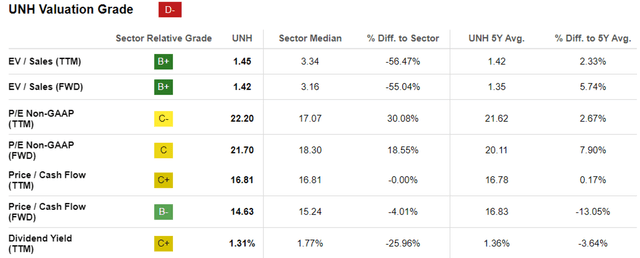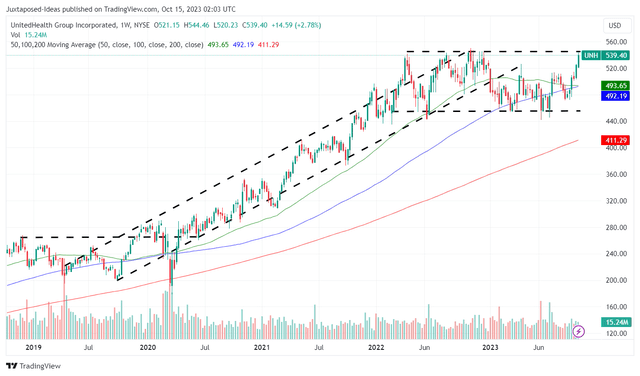Summary:
- UNH continues to demonstrate why it deserves its profitable growth premium, with one of the lowest Medical Care Ratio of 82.3% in FQ3’23, similar to its FY2019 levels.
- Much of its profitability tailwinds are directly attributed to the management’s strategic decision to vertically integrate its operations across different healthcare segments.
- Combined with its healthy balance sheet and moderating EBITDA to debt ratio, we are optimistic that UNH may continue to outperform, with a long-term PT of $684.85.
- However, investors must also be aware of the tightened regulatory scrutiny surrounding the managed healthcare industry, PBM space, and Medicare rating system.
- As a result, long-term UNH shareholders may want to size their portfolios according to their risk appetite, since these issues may pose headwinds to its future prospects and growth.
domin_domin
The UNH Investment Thesis Remains Robust As A Well Diversified Healthcare Provider
UnitedHealth Group (NYSE:UNH) is a company that dominates the healthcare space domestically and internationally, with one of the lowest Medical Care Ratio of 82.3% in FQ3’23 (-0.9 points QoQ/ +0.7 points YoY), similar to its FY2019 levels of 82.5% (+0.9 points YoY).
This is compared to its direct competitors, Centene (CNC) at 87% (inline QoQ/ +0.3 points YoY), CVS (CVS) at 86.2% (+1.6 points QoQ/ +3.5 YoY), Elevance Health (ELV) at 86.4% (+0.6 points QoQ/ -0.7 YoY), and Humana (HUM) at 86.3% (+0.8 points QoQ/ +0.5 YoY) in the latest quarters.
This ratio is important indeed, since a lower Medical Care Ratio implies reduced medical costs as a percentage of premium revenues, naturally triggering an improved bottom line.
Much of UNHs’ profitability tailwinds are directly attributed to the management’s strategic decision to vertically integrate its operations across:
- healthcare insurance, including Medicaid plans through the UnitedHealthcare segment.
- primary, specialty, urgent, and surgical healthcare services through the OptumHealth segment.
- healthcare consulting services to multiple organizations, including private practices and government hospitals through the OptumInsight segment.
- pharmacy services across retail consumers and specialty programs, through the OptumRx segment.
This decision has directly contributed to UNH’s efficient operations, allowing the management to keep costs within control while stimulating growth across different segments, partly aided by multiple acquisitions funded by debt.
As a result of this strategy, it is unsurprising that the healthcare leader has been able to expand its operating margins to 9.2% (+0.6 points QoQ/ inline YoY) in FQ3’23, compared to its FY2019 levels of 8.1% (+0.4 points YoY).
Despite UNH’s aggressive acquisitions worth over $43B over the past five years, we are still encouraged by the company’s healthy balance sheet, with $58.07B of long-term debts (-2% QoQ/ +27.8% YoY) and $44.09B in cash/ short-term investments (-4.7% QoQ/ +57.9% YoY).
Based on its annualized adj EBITDA of $38.12B in the latest quarter (+5% QoQ/ +14.9% YoY), we are still looking at a reasonable EBITDA to debt ratio of 1.52x, compared to FY2019 levels of 1.69x.
The robust profitability also means that UNH is more than capable to service its elevated annualized interest expenses of $3.33B (+1% QoQ/ +61.6% YoY), with a TTM interest coverage of 10.21x, improved than the sector median of 8.27x though moderated from its 5Y averages of 13.09x.
Investors must also note that the management has recently raised its FY2023 adj EPS guidance by +5.2% in the recent earnings call, from $23.67 to $24.92 at the midpoint, while double beating the consensus estimates for the FQ3’23 quarter.
This is why we believe that the UNH stock deserves its profitable growth premium, as demonstrated by its outperformance thus far.
The UNH Stock Deserves Its Growth Premium Indeed
UNH Valuations
For now, the UNH stock continues to trade near its 1Y and 5Y means, maintaining its premium over the sector medians.
Perhaps this is attributed to the optimistic consensus forward estimates, with the company expected to generate a robust top and bottom line growth at a CAGR of +9.5% and +12.5% through FY2025, compared to its normalized levels of +9.8% and +13.3% between FY2016 and FY2022, respectively.
UNH Valuations To Peers
These numbers well exceed UNH’s direct competitors over the same time period, including CNC with a forward estimate of +0.3%/ +9.1%, CVS at +3.9%/ +3%, and ELV at +6.7%/ +8.5%, respectively.
Investors may want to note that HUM is expected to generate a robust growth at +10.2%/ +14% as well, which explains the stock’s expanded valuations compared to the sector medians, similar to UNH.
Based on the consensus FY2025 adj EPS estimates of $31.56 and UNH’s FWD P/E valuations of 21.70x, we are looking at a long-term price target of $684.85 as well, implying an impressive upside potential of +26.9% from current levels.
Its income investment thesis remains robust, attributed to the stable FWD dividend yields of 1.31% and TTM Free Cash Flow Yield to Dividend Yield Ratio of 4.03%, compared to its 5Y average of 1.36% and 4.07%, respectively.
The UNH management’s focus on shareholders returns is also evident in its 5Y Dividend Growth Rate of +16.43%, compared to the sector median of +6.30%.
This is on top of the sustained share repurchases worth $24.33B since FY2019, with 30M shares retired since then, or approximately 3.1% of its float.
While it remains to be seen if the $3.29B Amedisys (AMED) acquisition may go through, with it currently facing certain regulatory scrutiny, we believe that the UNH management has displayed great ambition for growth while similarly expanding its vertically integrated health care offerings.
These efforts naturally cement its position as a titan in the managed health care space, while similarly demonstrating the management’s excellent use in Free Cash Flow generation of $26.43B over the LTM (-15.5% sequentially), compared to FY2019 levels of $19.88B (-1.2% YoY).
So, Is UNH Stock A Buy, Sell, or Hold?
UNH 5Y Stock Price
While we may rate the UNH stock as a Buy, thanks to its robust prospects of capital appreciation and dividend income as discussed above, there is no specific entry point to this rating, since it depends on individual investors’ dollar cost averages.
For now, it is unlikely that the stock may sustain the current rally above its critical resistance levels of $545s, attributed to its fair value of $540.76, based on the raised FY2023 adj EPS guidance of $24.92 (+12.3% YoY) at the midpoint and its FWD P/E valuations of 21.70x.
Therefore, interested investors may want to monitor the UNH stock’s movement for a little longer, before adding at any moderate pullbacks, preferably at its previous support range of between $490s and $450s for an improved margin of safety.
Do not chase this rally.
In addition, UNH investors must be aware of the potential risks associated with entering at this peak, since the regulatory scrutiny surrounding the managed healthcare industry has tightened, with its growth likely to decelerate if regulators tamp down on its future acquisitions.
We believe the company may not be immune from the ongoing correction in the Pharmacy-Benefit Manager space as well, with CVS expected to lose $50M in bottom line by 2025.
Furthermore, while UNH may currently boast an overall four-Star Ratings from Medicare, it remains to be seen if the same may continue in 2024, with CVS already expecting a $1B in annual operating income headwind as its Aetna National PPO plan rating declines by one star to 3.5 stars.
Lastly, with the embedded growth premium, the stock may experience a painful correction/ sell-off if the company ever misses the consensus estimates moving forward, especially given the US government’s crack-down on prescription costs from 2026 onwards.
As a result, long-term UNH shareholders may want to size their portfolios according to their risk appetite, especially since the uncertain regulatory landscape and elevated interest rate environment continue to present headwinds to its prospects.
Analyst’s Disclosure: I/we have no stock, option or similar derivative position in any of the companies mentioned, and no plans to initiate any such positions within the next 72 hours. I wrote this article myself, and it expresses my own opinions. I am not receiving compensation for it (other than from Seeking Alpha). I have no business relationship with any company whose stock is mentioned in this article.
The analysis is provided exclusively for informational purposes and should not be considered professional investment advice. Before investing, please conduct personal in-depth research and utmost due diligence, as there are many risks associated with the trade, including capital loss.
Seeking Alpha’s Disclosure: Past performance is no guarantee of future results. No recommendation or advice is being given as to whether any investment is suitable for a particular investor. Any views or opinions expressed above may not reflect those of Seeking Alpha as a whole. Seeking Alpha is not a licensed securities dealer, broker or US investment adviser or investment bank. Our analysts are third party authors that include both professional investors and individual investors who may not be licensed or certified by any institute or regulatory body.



